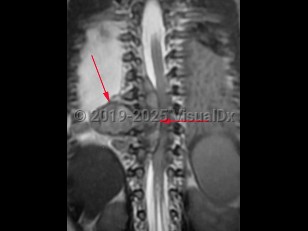Neuroblastoma is a neuroendocrine tumor that arises from neural crest cells. It is the most common solid tumor of infancy and childhood; typical age of onset is less than 3 years old. The adrenal glands are the most frequent site of origin, but this tumor can be found anywhere along the sympathetic nervous system chain including the neck, chest, abdomen, or pelvis. Presenting symptoms depend on the site of origin and areas of metastasis if present but may be nonspecific including fatigue, fevers, anorexia, abdominal pain, or joint or bone pains. Less common symptoms include weakness, ataxia, chronic diarrhea, hypertension, or shortness of breath. The presence of Horner syndrome or opsoclonus-myoclonus syndrome in children should prompt evaluation for this type of tumor. Rarely, neuroblastoma may be an incidental finding on radiology.
Treatment and prognosis depend on whether the tumor is low, intermediate, or high risk. Metastases are associated with a high mortality rate.
Neuroblastoma in Child
Alerts and Notices
Important News & Links
Synopsis

Codes
ICD10CM:
C74.90 – Malignant neoplasm of unspecified part of unspecified adrenal gland
SNOMEDCT:
432328008 – Neuroblastoma
C74.90 – Malignant neoplasm of unspecified part of unspecified adrenal gland
SNOMEDCT:
432328008 – Neuroblastoma
Look For
Subscription Required
Diagnostic Pearls
Subscription Required
Differential Diagnosis & Pitfalls

To perform a comparison, select diagnoses from the classic differential
Subscription Required
Best Tests
Subscription Required
Management Pearls
Subscription Required
Therapy
Subscription Required
References
Subscription Required
Last Reviewed:02/10/2019
Last Updated:04/25/2023
Last Updated:04/25/2023
Neuroblastoma in Child

